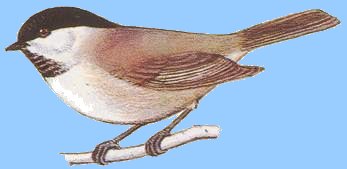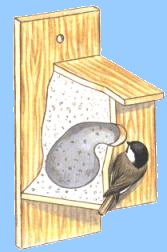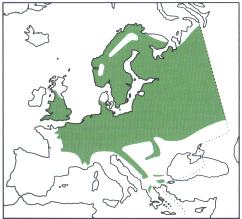Parus Montanus - Willow Tit
Source: British Garden Birds (www.garden-birds.co.uk)
| Length | 12 cm |
| Weight: | 9-11 g |
| Present: | All Year |
| Wing Span: | 17-18 cm |
| Breeding Pairs in Great Brittan: | 25 000 |
| Status: | Red List |
 Description
Description
The Willow Tit and the Marsh Tit are very
similar, and very difficult to tell apart. Indeed, the two were only recognised as
separate species at the end of the 19th century.
They both have black caps, sandy-brown upper parts, and buff underparts. The Willow Tit is
scruffier looking than the Marsh Tit: it has a duller cap, a large bib, a pale patch on
the wing (which is actually formed by pale edges to its secondary and tertial wing
feathers) and its bulging nape makes it look "bull-necked". The Coal Tit is similar, but has a white patch on the nape and a
much larger bib.
Voice
The Willow Tit has a buzzing nasal call, like "tchay-tchay-tchay", and its song is "pee-oo pee-oo".
 Feeding
Feeding
Willow Tits are not common garden birds, preferring damp woodland with birch and alder
trees, or hedgerows.
They feed on insects and seeds, and will take nuts, especially in wintertime.
Breeding
The female excavates a cavity in a dead tree or tree stump, which is then lined with
wood fibres, hair and feathers.They can be encouraged to use nest boxes, but these have to
be filled with wood chippings for the birds to excavate.
The small (16 mm by 12 mm) eggs are smooth and glossy, and white with reddish-brown
speckles. The female incubates the eggs by herself. After the young hatch, they are fed by
both parents.
| Breeding Starts | Number of Clutches | Number of Eggs | Incubation (days) | Fledge (days) |
| April-May | 1 | 5-13 | 13-15 | 17-19 |
Distribution

[ Home ] [ Bird overview ]